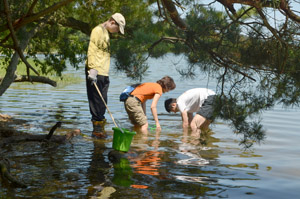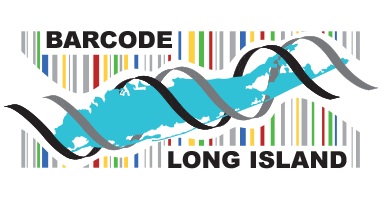Explore Long Island's DNA

In collaboration with Stony Brook University (SBU), Brookhaven National Laboratory (BNL), and the American Museum of Natural History (AMNH), the DNA Learning Center invites high school students and teachers to participate in Barcode Long Island (BLI). With funding from the National Institutes of Health (NIH), the project mission is for students to gain an intuitive understanding of the crucial interdependence between humans and the natural environment.
BLI uses DNA barcoding to explore, document, and track biodiversity on and around Long Island, through distributed experiments by student research teams, led by trained Long Island educators. BLI provides students with real and relevant research experience while they contribute to our knowledge of their environment. In addition, the project measures the effect on teachers and students and tests the feasibility of a large student-based barcoding initiative. BLI provides all the training, equipment, materials, and infrastructure needed to support this large-scale student-driven research effort.
Long Island represents a unique laboratory for studying the interaction of human beings with the natural landscape; it is a dynamic environment affected by ocean currents, sea level change, climate change, and human activity. Long-term human occupation, agricultural use, and increasing urbanization have had profound effects on the terrestrial and aquatic environments, affecting water quality, hydrology, soil, and radically changing both the flora and fauna. Conservation efforts also aim to restore or protect the remaining natural environments. These changes have implications for the health of the ecosystem and Long Island residents.
Among all this change, species lists and data on the ranges of species are often limited, especially for invertebrates, both aquatic and terrestrial, fungi, and non-vascular plants. A major hurdle to the mapping of species is the difficulty in identifying them. DNA barcoding reduces this barrier, allowing non-experts to objectively identify species once a DNA barcode is established. Just as the unique pattern of bars in a universal product code (UPC) identifies each consumer product, a "DNA barcode" is a unique pattern of DNA sequence that identifies each living thing.
Eligibility
The program is open to science or science research teachers from high schools on Long Island, in Brooklyn, or in Queens who attend a training workshop to become a certified mentor. Following training, teachers may mentor teams of 2–4 high school students enrolled in grades 9–12.
Teacher Training
Teacher training workshops held at the Dolan DNALC location in Cold Spring Harbor and DNALC NYC in Brooklyn introduce teachers to DNA barcoding, experimental design, laboratory and bioinformatics methods, kit components, and detail how teachers and students can participate in BLI campaigns. One and two-day workshops are offered throughout the school year and week-long workshops are offered during the summer.
Student Teams
With DNALC, SBU, AMNH, and BNL staff plus a network of scientists from local institutions as support, students are guided while they design experiments. Students are encouraged to seek out and collaborate with stakeholders, including governmental and private organizations, so their efforts synergize. Alternatively, student teams can opt to join BLI campaigns to document and map species diversity of key groups of organisms, including marine invertebrates, insects, invasive species, vectors for human disease, or biological indicators of water quality.
Wet Lab and Bioinformatics
Students prepare samples, isolate and amplify DNA or analyze their results at Open Lab sessions at BNL and DNALC facilities, or at their school using a footlocker containing all equipment and reagents needed to conduct the wet lab steps of DNA extraction, PCR, and gel electrophoresis. Once amplified, samples are sent for sequencing and automatically uploaded to the DNA Subway website for analysis.
Symposium
Each year, students present their results during a poster session at a BLI Symposium. In addition, experts are invited to speak about their efforts to study the biodiversity of Long Island.
Join us in this exciting opportunity to work along with scientists as we document and study the biodiversity of Long Island.
We are happy answer your questions. Just email us!



